In 2025, governance trends are at a crossroads, with transparency in governance becoming a buzzword that governments, corporations, and institutions can’t ignore. But is this push for openness genuine, or is it just lip service to appease stakeholders? This blog dives into the latest governance trends, exploring whether transparency is truly reshaping decision-making or if it’s merely a facade. Packed with insights, examples, and actionable takeaways, we’ll uncover what’s driving these shifts and what they mean for you.
Why Governance Trends Matter in 2025
Transparency in governance isn’t just a trendy term—it’s a demand from stakeholders, citizens, and employees who want accountability. In 2025, governance trends are shaped by technological advancements, public scrutiny, and evolving regulations. For example, the EU’s Corporate Sustainability Reporting Directive (CSRD) now mandates detailed disclosures, pushing companies toward openness. But are these changes delivering real results?
Here’s why governance trends are critical:
- Public Trust: 78% of consumers say they’d boycott brands lacking transparency, per a 2024 Edelman Trust Barometer.
- Regulatory Pressure: Governments worldwide are enforcing stricter compliance rules.
- Tech-Driven Accountability: AI and blockchain are making data harder to hide.

Transparency in Governance: What’s New in 2025?
AI-Powered Accountability
Transparency in governance is getting a tech boost. Governments and corporations are using AI to analyze and share data with stakeholders. For instance, Singapore’s government uses AI-driven dashboards to report public spending in real time, setting a global benchmark. However, critics argue that selective data sharing can still obscure the full picture.
Blockchain for Trust
Blockchain is another game-changer for governance trends. By creating tamper-proof records, it’s enabling transparent supply chains and voting systems. In 2025, Estonia’s blockchain-based e-governance model is inspiring others, though scalability remains a challenge.

Is Transparency in Governance Real or Just Talk?
The Case for Progress
Some organizations are walking the talk. Unilever’s 2025 sustainability report, for example, provides granular data on emissions and labor practices, earning praise for stakeholder trust. Governments like Canada are also experimenting with open data portals, making budgets and policies accessible.
The Skeptic’s View
On the flip side, greenwashing and selective transparency are rampant. A 2024 Transparency International report found that 40% of global corporations still withhold critical financial data. Critics argue that governance trends lean toward performative gestures rather than systemic change.
Key Takeaway: Transparency in governance requires consistent action, not just polished reports.
How to Navigate Governance Trends in 2025
Whether you’re a business leader, policymaker, or citizen, here’s how to engage with transparency in governance:
- Demand Clear Metrics: Push for measurable data, like emissions or diversity stats, not vague promises.
- Leverage Technology: Use tools like open data platforms to hold institutions accountable.
- Support Ethical Leadership: Back leaders who prioritize stakeholder trust over short-term gains.
- Stay Informed: Follow reputable sources like World Bank Governance Reports for updates.

The Future of Governance Trends: Transparency or Bust?
Looking ahead, governance trends in 2025 hinge on one question: Will transparency become a core value or remain a marketing ploy? The answer depends on collective action. Stakeholders must demand accountability, and leaders must deliver measurable results. As tech evolves and scrutiny intensifies, governance can’t hide behind empty promises.
Call to Action: Share your thoughts on transparency in governance below. Are you seeing real change, or is it just talk?

